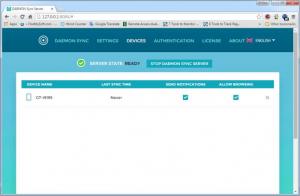

Create a replicated volume using the following command. Distributed Volume Performing Self-heal in GlusterFSġ. If a volume is expanded or shrunk in GlusterFS, the data needs to be re-balanced among the various bricks included in the volume. On adding one more brick to the volume, we may have to re-balance the total number of files among the two bricks. Now all the files are residing on the same brick since there is only brick in the volume. For instance we create 10 files on the volume through mount point. Replicated Volume What do we mean by Re-balance?Ĭonsider a distributed volume with only one brick. GlusterFS has an inbuilt self-heal daemon to take care of these situations whenever the bricks become online.

DAEMON SYNC PASSWORD RECOVERY OFFLINE
Same is the case with creation/modification of files on offline bricks. a synchronization between the replica bricks called as healing must be done. When the offline brick comes online at a later time, it is necessary to have that file removed from this brick also i.e. Assume that due to some failures one or more brick among the replica bricks go down for a while and user happen to delete a file from the mount point which will get affected only on the online brick. This feature is available for replicated volumes. What do we mean by Self-heal on replicated volumes? Let us get familiar with the terms Self-heal and Re-balance. It is worth mentioning about the two important features, Self-heal and Re-balance, in this article without which explanation on GlusterFS will be of no use. In my previous article on ‘ Introduction to GlusterFS (File System) and Installation – Part 1‘ was just a brief overview of the file system and its advantages describing some basic commands.


 0 kommentar(er)
0 kommentar(er)
